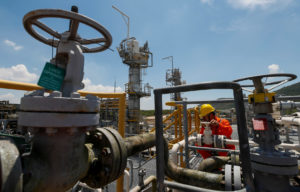
Vietnam’s state energy companies gear up for LNG imports
Petrolimex and PetroVietnam prepare to serve the needs of the energy-hungry nation
9 March 2019
Vietnam’s Petrolimex has unveiled plans to open its first liquefied natural gas import terminal, following in the footsteps of fellow state-run energy group PetroVietnam, as the pair work to diversify energy supplies to fend off a chronic power shortage in the Southeast Asian country.
“We will put our efforts into the LNG business as a new area for growth,” Petrolimex Chairman Pham Van Thanh told Nikkei.
Petrolimex, formally known as Vietnam National Petroleum Group, controls about half of Vietnam’s gas stations. The company had sought to diversify by building the country’s third oil refinery, at a cost of around $4.5 billion. But Petrolimex was forced to give up on the project last fall after the government, concerned about excess capacity, balked at providing financial support.
Now Petrolimex will focus on building an LNG terminal in the southern coastal province of Khan Hoa. The intake facility will sit next to a petroleum storage depot. The LNG will be supplied to a gas-fired power plant to be built nearby by Vietnam Electricity, the state provider known as EVN.
By the time the plant is up and running as scheduled in the late 2020s, it will supply customers with 6,000 megawatts of energy. The entire investment, including the terminal and the power plant, will reach about $3.6 billion.
This follows PetroVietnam’s plans to construct Vietnam’s first LNG terminal at the southern port of Thi Vai. Winning bids for the project will be finalized this month. PetroVietnam, also known as Vietnam Oil and Gas Group, could break ground as soon as this year, with operations slated to begin in 2023 at the earliest. The 1 million tons of LNG the terminal will be capable of importing annually will fuel multiple power plants to be built concurrently, with their combined output reaching 1,500 MW.
Nearly 10 LNG terminals are in the planning stages around Vietnam, including a project in Binh Thuan Province by PetroVietnam and U.S. power company AES. Driving this noticeable shift to natural gas is the country’s emergence as a global manufacturing hub.
Manufacturers worldwide, including those leaving China due to its mounting labor costs, are increasingly setting up shop in Vietnam. Samsung Electronics built a string of plants in the country to serve the global smartphone market.
Meanwhile, Vietnam’s electricity demand has grown by 10% a year, faster than economic growth in large part due to the spread of air conditioners. Power plant construction has been unable to keep up.
Vietnam Deputy Prime Minister Trinh Dinh Dung warned that the electricity supply crunch will remain a chronic problem for some time. He ordered the rapid construction of power plants, especially in the southern region where the problem is more severe.
Vietnam is a coal-producing country, meaning coal-fired plants account for nearly 40% of the country’s power output, on a par with hydroelectric power. The nation’s native natural gas reserves will continue to account for about a fifth of the energy mix.
More coal plants are expected, but they leave a large carbon footprint. Miners have also all but exhausted coal from easily accessible sites, and the cost of procuring the fuel is projected to climb.
The Vietnamese government initially considered nuclear energy, but the 2011 meltdown at Japan’s Fukushima squelched those plans.
Officials then hit on natural gas, which emits less carbon than coal. But Vietnam’s gas production is destined for a precipitous drop after 2020 as the fields are exhausted. So LNG will be imported to fill the gap.
Vietnam will be joining its neighbors in its newfound embrace of LNG. Thailand, which became the first Southeast Asian nation to import the fuel in 2011, took in 3.95 million tons in 2017, a 30% jump from the previous year. Malaysia’s imports climbed 40% to 1.8 million tons. Indonesia, which had been an LNG exporter, will begin importing in the early 2020s, as will the Philippines.
Southeast Asia is becoming a major LNG consumer. Global LNG demand rose 8.5% to 380 million tons last year, according to Bloomberg New Energy Finance. That number is forecast to hit 450 million tons in 2030. Asia will account for 86% of the 167 million additional tons of LNG consumed from 2017 to 2030. Of that, Southeast Asia is expected to use 44 million tons, just behind India’s 61 million tons and China’s 53 million tons.
For Vietnam, questions remain over how it will be able to pay for its LNG ambitions. The country caps public debt at 65% of gross national product, and it is nearing that ceiling. Funds raised overseas by state companies could be added to the debt load. Major LNG projects will have to compete with a host of other proposed infrastructure projects for government approval.
Source: https://asia.nikkei.com/Business/Markets/Commodities/Vietnam-s-state-energy-companies-gear-up-for-LNG-imports
